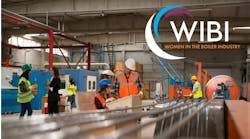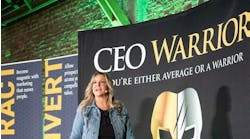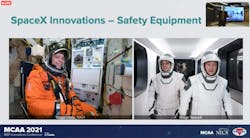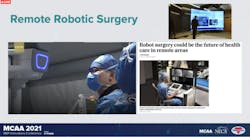The MCAA held its annual MEP Innovation Conference over three days, April 26-28. The conference was moved from its typical January dates to accommodate its transition to a virtual format.
This year, the conference looked to build on its previous success by inviting more union-affiliated sub-contractors to participate, and now it includes content for mechanical, plumbing, service, electrical and sheet metal contractors. To that end, the MCAA partnered with NECA and SMACNA as well as extended MCAA member pricing to their membership. Sponsors of the event included Trimble, Milwaukee Tool and Dado.
In addition to roundtable discussions and exhibitor demonstrations, various breakout sessions covered a wide range of topics. Notable sessions (listed here with their presenters) included:
- Low Cost Tech for Smaller Contractors – Carlos Osorio, VDC/BIM Manager, Mann Mechanical
- Field Foremen Tech Tools -- Trent Leinenbach , VDC and Technology Manager, NNorth Mechanical Contracting, Inc., DJ Phipps , Sr. Strategic Product Consultant, Procore, and Jeff Elwell , Director of Innovation and Technology, EM Duggan
- VDC 101 For Project Managers -- Stacy Zerr , Director of PreConstruction Services, The Waldinger Corporation
- Diversity, Culture and Resilience to Future-proof Your Company -- Tauhira Ali , Executive Director of Industry Innovation, NECA
- Fabrication 101 -- Greg Fuller , President, North Mechanical Contracting, Inc.
For a full list of sessions, visit https://www.mcaaevents.org/innovative-technologies-conference/. Registration is required. In all, 34 sessions are available for view.
Innovations from Other Industries
If there was a single session that captured the overall theme of the conference, it was the closing general session, Innovations From Other Industries That Can be Applied to Construction, presented by James Benham, CEO of JBKnowledge, a technology solutions provider for the insurance and construction industries.
Benham posited that with $1.7 Trillion spent worldwide annually on R&D, amazing innovations have been made in science and technology that might not originally be thought to apply to construction. While some of these discoveries might be very far off in the distant future, others like robotics, artificial intelligence and virtual reality are making their way to the construction industry today.
The challenge that the construction industry faces is that job sites are not controlled environments, and each project is essentially its own prototype. For innovations to work, they must be adaptable, rugged and intelligent.
Benham then took a step back to make two important points about innovation. First, that innovation can’t just be about technology, it has to be about people, processes and technology. Second, that innovation is about improving efficiency and effectiveness. It is possible to become highly efficient at things that are totally ineffective, what Benham referred to as, “sucking at a high rate of speed.”
But by looking to other industries construction companies can find best practices, proven solutions, and inspiration that can create real innovations that will have a big impact on their businesses. He then took examples from several industries in turn.
Also, they look good—and frankly, people want to look good, even when they’re on the job site.
Benham turned again to the user experience with a look at the SpaceX cockpit, and compared it to that of the Apollo program and the Space Shuttle. The dramatic simplification allows users to make better use of muscle memory when operating the craft, making for more consistent, responsive operation. It also made training faster and simpler. Imagine that same thinking applied to a piece of construction equipment.
Reusability and automation have helped change the nature of space exploration. By reusing rockets, by automating systems (including heavy equipment and data capture), the space industry has been able to lower costs and remove barriers to affordability for its customers.
SpaceX also made strides in vertical integration, seizing control of its own supply chain when it became difficult to obtain parts. In much the same way, fabrication can give people in the construction industry that same independence.
Academia can serve as a model for cross-disciplinary collaboration. The convergence of construction science and computer science, of economics and industrial engineering, is all happening right now on university and college campuses
Manufacturing is, naturally, way ahead of most of the prefab facilities being used in construction. A lot more is being done with robotics and automation. While insisting his presentation was not going to be a long love letter to Elon Musk, Benham looked to Tesla as an example of a manufacturer whose innovations were something the construction industry could learn from.
Industrial 3D printing will, in the next decade or less, become a real game-changer. The complexity, speed and scale of what industrial 3D printers are able to accomplish are all developing rapidly. There are still issues with standards, both of operation and for safety, but the potential is too great to ignore. The potential in prototypes of tools and equipment for buildings is amazing.
Disney acquired Pixar as much for its storytelling as for its computer code. The approach is “stacking,” where good software and tools allows a business to create better software and tools (generative design) with better results all around. Just look at the progress of the Woody character from Toy Story 1 to Toy Story 4; the modeling, the depth, the realism. And we all know the more realistic the render is, the more a client will understand it.
Healthcare, Financial Services, Insurance, Transportation, Computer Science were all fields doing exciting work, producing innovations that could or could some day be adopted by the construction industry to speed efficiency and effectiveness.
To wrap up, Benham offered the audience a few takeaways to keep in mind. First, that automation and Artificial Intelligence, working together, will be changing construction in important ways. The sooner you embrace them the better it will be for your business. Next, study other industries, even those way outside of your comfort zone, and pay attention to the common themes you find.
Benham then concluded by thanking the sponsors, the host associations and everyone for attending.




